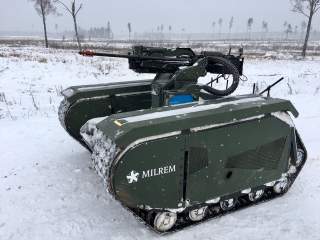Could This Estonian Robot Tank Stop a Russian Invasion?
Let's take a look.
Key point: The Baltic states take their defense and technology seriously.
An Estonian company has teamed up with a Singaporean firm and joined the expanding global race to develop robotic fighting vehicles.
More and more firms are developing armed unmanned ground vehicles, some as private ventures and others in response to formal government programs. But it’s unclear how quickly armies might actually field meaningful numbers of tank-like ground robots.
News broke in June 2019 that Estonia’s Milrem Robotics and Singapore’s ST Engineering had tested a new UGV. “The companies demonstrated the UGV during a live-fire exercise held in Tapa, Estonia,” Estonian World reported.
“The new UGV is armed with a 40-millimeter automatic grenade launcher and a 12.7-millimeter heavy machine gun,” according to Estonian World.
“Our joint combat UGV is one of the first armored UGVs in the world that’s especially well-suited for urban conflict areas,” Jüri Pajuste, a Milrem Robotics director, told the publication.
The joint warfare system consists of the THeMIS unmanned ground vehicle and the ADDER DM Remote Weapon Station and is intended as a force multiplier for dismounted troops that can be utilised in both urban and rural areas, the companies said in a statement.
The combat UGV is a tracked all-terrain system with ground clearance up to 60 centimetres (23.6 inches) that can negotiate 60-percent slopes and pass 61-centimetre (24-inch)-deep water obstacles. Its top speed is 20 kilometres an hour (12 miles per hour) and it’s powered by a diesel-electric drive that, depending on the mission, can offer 15 hours of constant operations without refueling, the companies added.
The combat UGV is configured for wireless control from a distance of 1,000 meters (0.6 miles) and 2,500 meters (1.55 miles) in urban and rural areas, respectively.
The operator can command the system from an ergonomically-designed mobile or stationary crew station that is matched with a graphical user interface for intuitive workflow and task execution. The system significantly decreased the cognitive workload on the operator, reducing operator fatigue and improving combat performance, the companies said.
Milrem’s UGV joins a growing field of in-development robotic tanks. British company QinetiQ in April 2019 deployed armed Titan UGVs to provide overwatch and fire support during a Royal Marines beach-assault exercise.
The U.S. Army meanwhile has begun shopping around for a robotic armored vehicle that can replace some of the branch's old M-2 Bradley manned fighting vehicles. Some initial testing took place as early as 2017, when an armed, robotic M-113 vehicle provided covering fire for soldiers during a war game in Michigan.
Russia more than most countries is in a hurry to actually field armed UGVs. But the country’s hurry has resulted in some serious failures.
The Russian military in May 2018 deployed to Syria at least one Uran-9 remote-controlled tank. Just a month later, the Kremlin admitted the UGV wasn’t ready for front-line use.
“Modern Russian combat unmanned ground vehicles are not able to perform the assigned tasks in the classical types of combat operations,” senior research officer Andrei Anisimov said at a conference at the Kuznetsov Naval Academy in St. Petersburg.
U.K. company BAE Systems conducted an in-house study that echoed, and even directly quoted, Anisimov’s own assessment. Beside being incapable of handling “assigned tasks in the classical types of combat operations,” the radio-controlled Uran-9 possesses “thermal and electro-optical sensors proved incapable of spotting enemies beyond 1.25 miles,” according to BAE.
“Sensors, and the weapons they guided, were useless while the Uran-9 was moving due to a lack of stabilization,” the British company added. “When commands were issued, there were significant delays.” Uran-9 also is “vulnerable” to radio jamming, which can result in “loss of communications/control.”
The Kremlin reportedly is upgrading Uran-9 in an effort to solve some of the UGV’s problems. But Anisimov and BAE agreed that it would be 10 to 15 years before UGVs are ready for “such complex tasks” as direct ground combat.
Milrem like many companies still is searching for customers for its robotic tank. It’s unclear whether Russia’s own disappointing experience has cooled armies’ interest in acquiring armed UGVs. Robotic tanks are on the way. But we don’t know yet how fast they might arrive.
David Axe serves as Defense Editor of the National Interest. He is the author of the graphic novels War Fix, War Is Boring and Machete Squad. This first appeared in June 2019.
Image: Twitter/Milrem

